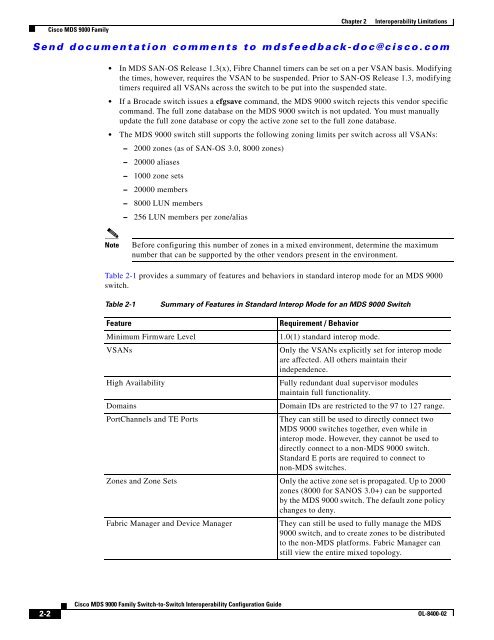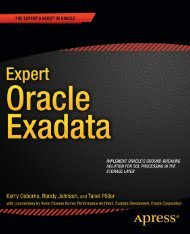Cisco MDS 9000 Family Switch-to-Switch Interoperability ...
Cisco MDS 9000 Family Switch-to-Switch Interoperability ...
Cisco MDS 9000 Family Switch-to-Switch Interoperability ...
You also want an ePaper? Increase the reach of your titles
YUMPU automatically turns print PDFs into web optimized ePapers that Google loves.
<strong>Cisco</strong> <strong>MDS</strong> <strong>9000</strong> <strong>Family</strong><br />
Chapter 2<br />
<strong>Interoperability</strong> Limitations<br />
Send documentation comments <strong>to</strong> mdsfeedback-doc@cisco.com<br />
• In <strong>MDS</strong> SAN-OS Release 1.3(x), Fibre Channel timers can be set on a per VSAN basis. Modifying<br />
the times, however, requires the VSAN <strong>to</strong> be suspended. Prior <strong>to</strong> SAN-OS Release 1.3, modifying<br />
timers required all VSANs across the switch <strong>to</strong> be put in<strong>to</strong> the suspended state.<br />
• If a Brocade switch issues a cfgsave command, the <strong>MDS</strong> <strong>9000</strong> switch rejects this vendor specific<br />
command. The full zone database on the <strong>MDS</strong> <strong>9000</strong> switch is not updated. You must manually<br />
update the full zone database or copy the active zone set <strong>to</strong> the full zone database.<br />
• The <strong>MDS</strong> <strong>9000</strong> switch still supports the following zoning limits per switch across all VSANs:<br />
– 2000 zones (as of SAN-OS 3.0, 8000 zones)<br />
– 20000 aliases<br />
– 1000 zone sets<br />
– 20000 members<br />
– 8000 LUN members<br />
– 256 LUN members per zone/alias<br />
Note<br />
Before configuring this number of zones in a mixed environment, determine the maximum<br />
number that can be supported by the other vendors present in the environment.<br />
Table 2-1 provides a summary of features and behaviors in standard interop mode for an <strong>MDS</strong> <strong>9000</strong><br />
switch.<br />
Table 2-1<br />
Summary of Features in Standard Interop Mode for an <strong>MDS</strong> <strong>9000</strong> <strong>Switch</strong><br />
Feature<br />
Minimum Firmware Level<br />
VSANs<br />
High Availability<br />
Domains<br />
PortChannels and TE Ports<br />
Requirement / Behavior<br />
1.0(1) standard interop mode.<br />
Only the VSANs explicitly set for interop mode<br />
are affected. All others maintain their<br />
independence.<br />
Fully redundant dual supervisor modules<br />
maintain full functionality.<br />
Domain IDs are restricted <strong>to</strong> the 97 <strong>to</strong> 127 range.<br />
They can still be used <strong>to</strong> directly connect two<br />
<strong>MDS</strong> <strong>9000</strong> switches <strong>to</strong>gether, even while in<br />
interop mode. However, they cannot be used <strong>to</strong><br />
directly connect <strong>to</strong> a non-<strong>MDS</strong> <strong>9000</strong> switch.<br />
Standard E ports are required <strong>to</strong> connect <strong>to</strong><br />
non-<strong>MDS</strong> switches.<br />
Zones and Zone Sets Only the active zone set is propagated. Up <strong>to</strong> 2000<br />
zones (8000 for SANOS 3.0+) can be supported<br />
by the <strong>MDS</strong> <strong>9000</strong> switch. The default zone policy<br />
changes <strong>to</strong> deny.<br />
Fabric Manager and Device Manager<br />
They can still be used <strong>to</strong> fully manage the <strong>MDS</strong><br />
<strong>9000</strong> switch, and <strong>to</strong> create zones <strong>to</strong> be distributed<br />
<strong>to</strong> the non-<strong>MDS</strong> platforms. Fabric Manager can<br />
still view the entire mixed <strong>to</strong>pology.<br />
2-2<br />
<strong>Cisco</strong> <strong>MDS</strong> <strong>9000</strong> <strong>Family</strong> <strong>Switch</strong>-<strong>to</strong>-<strong>Switch</strong> <strong>Interoperability</strong> Configuration Guide<br />
OL-8400-02











